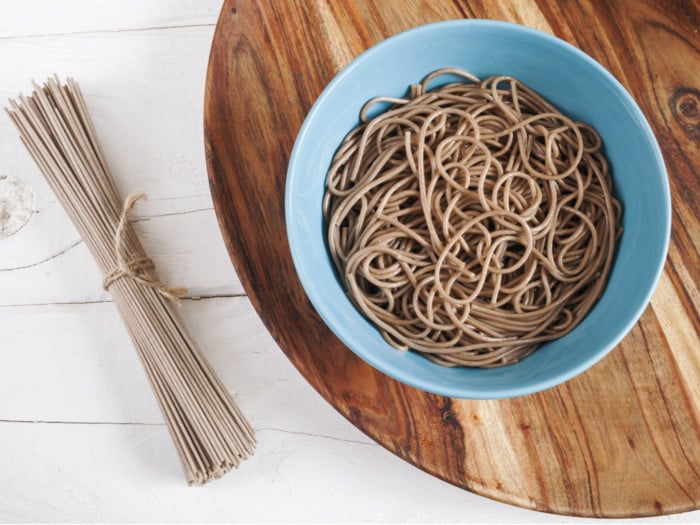Soba noodles are eaten in many parts of the world and are widely praised for their unique nutrients, flavor, and potential health benefits.
What are Soba Noodles?

Soba noodles are Japanese noodles made of buckwheat and taste delicious hot or cold. Photo Credit: Shutterstock
Soba noodles are traditional Japanese noodles made from buckwheat flour and have been an important part of their cultural cuisine for hundreds of years. Given that much of the carbohydrate consumption in Japan comes from white rice or wheat flour, soba (buckwheat) provides an alternative that can deliver different nutrients and ensure a well-rounded diet. For those people who are unable to consume gluten (wheat products), soba is an excellent alternative. These noodles are also very popular because of their versatility in both hot and cold preparations, making them an important caloric element all year round. [1]
Serving Size : Nutrient Value Water [g] 73.01 Energy 99 Energy [kJ] 414 Protein [g] 5.06 Total lipid (fat) [g] 0.1 Ash [g] 0.39 Carbohydrate, by difference [g] 21.44 Calcium, Ca [mg] 4 Iron, Fe [mg] 0.48 Magnesium, Mg [mg] 9 Phosphorus, P [mg] 25 Potassium, K [mg] 35 Sodium, Na [mg] 60 Zinc, Zn [mg] 0.12 Copper, Cu [mg] 0.01 Manganese, Mn [mg] 0.37 Thiamin [mg] 0.09 Riboflavin [mg] 0.03 Niacin [mg] 0.51 Pantothenic acid [mg] 0.24 Vitamin B-6 [mg] 0.04 Folate, total [µg] 7 Folate, food [µg] 7 Folate, DFE [µg] 7 Fatty acids, total saturated [g] 0.02 14:0 [g] 0 16:0 [g] 0.01 18:0 [g] 0 Fatty acids, total monounsaturated [g] 0.03 16:1 [g] 0 18:1 [g] 0.03 Fatty acids, total polyunsaturated [g] 0.03 18:2 [g] 0.03 18:3 [g] 0 Tryptophan [g] 0.07 Threonine [g] 0.18 Isoleucine [g] 0.2 Leucine [g] 0.33 Lysine [g] 0.21 Methionine [g] 0.07 Cystine [g] 0.09 Phenylalanine [g] 0.22 Tyrosine [g] 0.11 Valine [g] 0.25 Arginine [g] 0.32 Histidine [g] 0.12 Alanine [g] 0.25 Aspartic acid [g] 0.37 Glutamic acid [g] 1.1 Glycine [g] 0.33 Proline [g] 0.31 Serine [g] 0.26 Sources include : USDA [2]
Soba Noodles Nutrition
When it comes to nutrition, a 2-ounce serving of soba noodles contains approximately 200 calories. However, buckwheat is also a rich source of certain B vitamins, such as thiamine, and also possesses all eight essential amino acids, unlike wheat. These noodles are also high in powerful antioxidants, such as quercetin and rutin, as well as dietary fiber. In terms of minerals, these noodles have moderate amounts of iron, potassium, phosphorus, zinc, and calcium, among others. [3]
How to Make Soba Noodles?
Making soba noodles is slightly different than cooking other pasta, but just as easy.

Healthy Soba Noodles Recipes
Ingredients
- 1 pack soba noodles
- Water for boiling
- Salt to taste
Instructions
- Bring a large pot of water to boil on the stove.
- Add salt to the water before adding the soba noodles.
- Cook until the noodles become soft, but be careful, as the noodles can easily overcook and become mushy.
- Drain the water and run the pasta under cold water immediately (if you want the noodles for a cold dish).
Health Benefits of Soba Noodles
The most impressive health benefits of soba noodles include their ability to boost gut health, minimize varicose veins, and prevent heart disease, among others.
Prebiotic
These noodles are considered prebiotic because of the effect they have on gut health. Prebiotics are foods or supplements that improve gut health by feeding beneficial bacteria. While some of the side effects are related to the stomach, the benefits typically outweigh the risks. [4]
Varicose Veins
An overlooked benefit of these noodles is their impact on cardiovascular and circulatory health, namely in strengthening the walls of our veins and blood vessels. This can help protect against poor artery integrity and lower your risk of atherosclerosis. [5]
Protein Density
There might be a good amount of protein in these specialized noodles, but much of it is undigestible. Buckwheat pasta does contain between 6 and 8 grams of protein per 2-ounce serving, making it an excellent means of boosting growth and development, which require amino acids from other protein sources. [6]
Diabetes
While the glycemic load of soba noodles is not incredibly high, it is still slightly above whole-grain pasta. However, due to the fact that soba noodles are rich in fiber, they can also help to regulate blood sugar with its high level of fiber, thus helping to lower your risk of diabetes. [7] [8]
Heart Disease
With so many minerals and antioxidants, as well as good levels of fiber and protein, these noodles can provide a foundation of support for the heart and lower your risk of metabolic syndrome, atherosclerosis, heart attack, and stroke. [9]
Soba Noodles Precaution: When you switch from wheat pasta to soba noodles, you will be losing some of the minerals, such as selenium and iron, that are found in higher quantities in wheat. Furthermore, soba noodles have a relatively high glycemic load, which could be slightly dangerous for people with diabetes, unlike whole-grain pasta, for example. Whenever you change your diet, it is a good idea to speak with your doctor about how that change could affect your overall health. Finally, if you are eating these noodles because they are gluten-free, read all packaging carefully, as some are a mixture of buckwheat and wheat.
